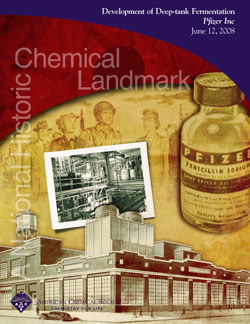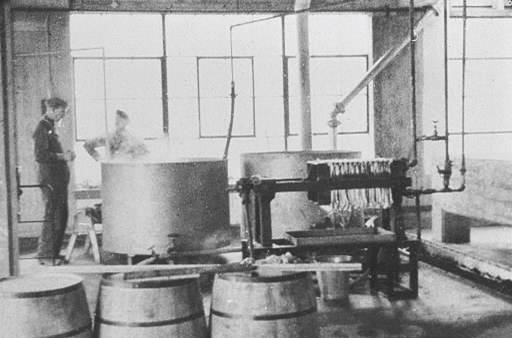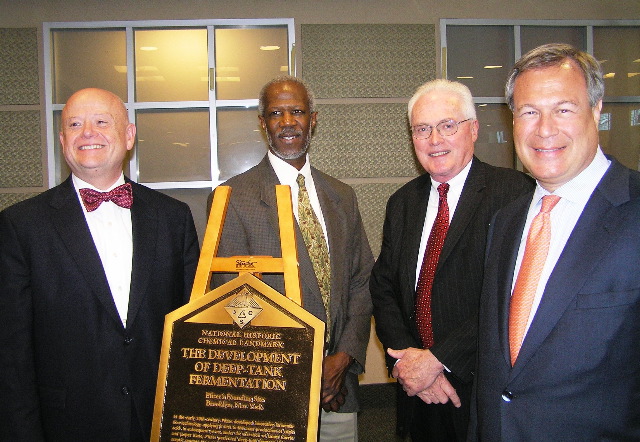Penicillin Production through Deep-tank Fermentation
Dedicated June 12, 2008, at Pfizer, Inc.’s Marcy Avenue facility in Brooklyn, New York City, New York.
During World War II, the governments of the United States and the United Kingdom approached the largest U.S. chemical and pharmaceutical companies to enlist them in the race to mass produce penicillin, the “wonder drug.” One of these companies, Pfizer, succeeded in producing large quantities of penicillin using deep-tank fermentation. Its success helped make penicillin available to Allied soldiers by the end of the war.
Contents
The Penicillin Problem
The story of Alexander Fleming’s discovery of penicillin has been told often. Fleming was already well known for his earlier work on staphylococci when, upon returning from a long holiday in September 1928, he noted that one petri dish contained colonies of Staphyloccus except for clear area contaminated with a fungus that appeared to inhibit bacterial growth. Fleming identified the contaminant as a strain of Penicillium and he found that it killed a host of Gram-positive bacteria, including those that caused scarlet fever, pneumonia, gonorrhea, meningitis and diphtheria.
Cultivating penicillin proved difficult and the small quantities that could be produced were unstable. Fleming also believed that penicillin would not remain in the human body long enough to kill bacteria. Taken together, these facts convinced Fleming that penicillin would never be an important antibiotic for treating infections. For the next decade, penicillin remained a laboratory curiosity, until Howard Florey and a team of researchers at Oxford University demonstrated its potential life-saving properties. The researchers also discovered a method to purify penicillin and to keep it in a stable form. By 1940, clinical trials were underway and their success led to the hunt for a method to manufacture this “wonder drug.” But by then England was at war, making mass production difficult. So the question remained: how to produce penicillin on a large scale?
Pfizer’s Growth with Citric Acid and Fermentation
The answer begins with a small chemical company that would grow into a pharmaceutical giant.
Charles Pfizer and Charles Erhart, cousins and recent émigrés from Germany, established Charles Pfizer & Company in the Williamsburg neighborhood of Brooklyn in 1849. The company’s first product cured a common 19th-century malady, intestinal worms, which were usually treated with santonin, an anti-parasitic so bitter that most people thought the cure worse than the condition. But the cousins, pooling the skills of Pfizer, a chemist, and Erhart, a confectioner, blended santonin with an almond-toffee flavoring to create a candy-flavored medicine that patients would take.
Pfizer’s initial success with santonin encouraged the cousins to look for other opportunities to manufacture “fine chemicals.” Among the company’s products were quinine, used as an analgesic; borax, used as a preservative and a laundry detergent; boric acid, a topical antiseptic; cream of tartar, used in baking powder; and tartaric acid, also used in foods (both by-products of the European wine industry); Rochelle salts, a laxative and diuretic; camphor, a painkiller; and strychnine, a tonic and appetite stimulant. During the Civil War, Pfizer, like other chemical and pharmaceutical companies, responded to the demand for painkillers, preservatives and disinfectants, producing many products with medicinal applications, including iodine, morphine and chloroform.
Pfizer’s initial blockbuster product was citric acid, which it added to its product line in the 1880s. Citric acid is used in foods and beverages—notably soft drinks—because it is a natural preservative which can also add an acidic, slightly sour, taste. By supplying citric acid for new, popular drinks like Coca-Cola, Pepsi-Cola and Dr. Pepper, Pfizer was able to dominate the market. At first, the company used the standard production methods, obtaining citric acid from unripe fruit from Italy, California, Florida and the West Indies, and treating it with lime (CaO) and sulfuric acid to yield a solution of crystallized citric acid.
The botanist Carl Wehmer discovered in 1893 that the Penicillium mold could produce citric acid from sugar. Later, J.A. Martin discovered that fermenting sugar could yield citric acid. But these were ideas ahead of their time because no one knew how to manufacture citric acid from these sources on a commercial scale. That is, until James Currie, a food chemist, discovered that citric acid could be fermented from certain strains of the mold Aspergillis niger combined with sugar.
Currie later described how he took his discovery to Pfizer in 1917: “I met with John Anderson, who was Pfizer’s chairman of the board. During our first meeting, Mr. Anderson introduced me to another Pfizer official with the remark, ‘Dr. Currie is up here now and I think he has something interesting.’” Pfizer officials quickly realized that the “something interesting” was the prospect of producing vast quantities of citric acid from sugar, rather than from imported citrus fruit.
The fact that Currie joined Pfizer during World War I was no coincidence. Pfizer officials, led by John Anderson, realized that the company had to reduce its vulnerability as an importer of raw materials. The war cut off the supply of Italian citrus, and all raw material deliveries from Europe were threatened by the German submarine blockade. Supplying medicines and chemicals for the war helped the company survive, but overall sales declined. Now, more than ever, Pfizer needed to find ways to produce citric acid without using citrus.
Currie, aided by his precocious 16-year-old lab assistant Jasper Kane, tackled the fermentation problem. He knew Aspergillis niger is aerobic, meaning it needs air to grow. Currie tried to grow the mold in a large flat pan, but had limited success. He cut the pan into smaller, shallower pans, and immediately increased the yield. Still, the process was subject to a number of variables: the quality of the mold spores, the purity of the cultures, contamination of air and the medium, humidity and temperature, and many others.
Currie plugged on, turning to Gordon Dryer machines, which controlled humidity and temperature. He also experimented with different-sized pans and their depth and temperatures. In 1919 Pfizer opened a pilot plant using his fermentation process, named SUCIAC—“Sugar Under Conversion to Citric Acid.” Still, yields were disappointingly low for a time, so Currie kept fine tuning the process, using smaller pans and a better ventilation system to increase output. By 1924 growing yields of citrus acid convinced Pfizer officials to build a SUCIAC plant. The new structure began operating in 1926; that year the output of citric acid using fermentation technology far outpaced the production based on lemons and limes. By the end of the decade Pfizer was dominating the market and in 1929 the company reached a milestone; it produced 5.9 million pounds of citric acid without using any lemon juice, lime juice or foreign citrate of lime in its production process.
Development of Deep-tank Fermentation
Pfizer’s experience with fermentation in the production of citric acid provided valuable lessons for the company when biochemistry created new germ-killing antibiotics, many of which could be produced in the laboratory but not on a commercial scale. And Pfizer gained even more experience as the company searched for ways to use fermentation to produce other chemicals or to improve existing methods. For example, in 1933, Jasper Kane substituted molasses, a cheap by-product of sugar refining, for sugar in the fermentation of citric acid.
Pfizer soon was producing other products by fermentation, most notably gluconic acid (C6H12O7), used as an additive in food to regulate acidity and as a cleaning agent. Unlike the case of citric acid, an important product that Pfizer sought to produce more efficiently, Pfizer succeeded in marketing gluconic acid only after developing a commercial process involving deep-tank fermentation. Pfizer had tried unsuccessfully to use deep tanks to produce citric acid; in 1929 the company succeeded in producing gluconic acid in a submerged aerobic medium in stirred deep tanks which controlled for pH and the sterility of the air.
In the following years the company used fermentation processes to produce itaconic acid, fumaric acid and intermediates for chemical synthesis. The production of gluconic acid and other products using deep-tank fermentation was a significant breakthrough for Pfizer. While the company used fermentation techniques in manufacturing citric acid, it was the development of deep tanks for gluconic acid that paved the way for the successful mass production of penicillin.
In the 1930s Pfizer, which had close ties with the pharmaceutical and food industries, became interested in the commercial production of vitamins, beginning with vitamin C. Ascorbic acid was first isolated by Albert Szent-Györgyi in 1928; shortly after, its structural formula was established and a method of synthesis discovered. 1936 Pfizer began marketing synthetic vitamin C made with submerged fermentation as the first step in the process. Pfizer soon became the leading manufacturer, and the company decided to market other vitamins, introducing vitamin B2 in 1938 and, after the war, vitamin B12.
Penicillin Production by Deep-tank Fermentation
In 1941 the British government sought help from the U.S. scientific community in solving the problem of mass producing penicillin. Four chemical and pharmaceutical companies, Pfizer included, responded, plunging into the race to produce the world’s first “wonder drug.”
In the early 1940s Jasper Kane and his colleagues increased penicillin production incrementally as well as the drug’s potency and purity, but the gains were frustratingly slow. At first, Kane used flasks and pans similar to the fermentation techniques for citric acid. In 1942, Kane suggested switching to the deep tanks that worked so well for gluconic acid. Kane’s suggestion was risky for it meant Pfizer would have to curtail production of other, more profitable products while it concentrated on penicillin. As one executive, John Smith, said: “The mold is as temperamental as an opera singer, the yields are low, the isolation murder, the purification invites disaster. Think of the risks!”
The company decided to take the gamble. In September 1943 it purchased the old Rubel Ice Plant on Marcy Avenue in Brooklyn, a nearby building that had the refrigeration equipment required, rebuilding it into the world’s first large-scale penicillin factory. On March 1, 1944 Pfizer’s penicillin plant opened. It contained fourteen 7,500-gallon tanks; soon the company was producing five times more penicillin then originally estimated, making Pfizer the leading supplier of the drug; most of the penicillin that went ashore with Allied forces on D-Day came from this plant.
Behind the numbers stood a marvel of chemical engineering. Production began with a sterile culture of the penicillin mold, which then was propagated, first in three-liter flasks, next in 200-gallon “seed” tanks. The culture then moved to huge fermenter tanks containing microbe fodder, chiefly corn steep liquor, milk sugar, salts and minerals. The mold was allowed to grow for two to four days.
Although the whole process was difficult, the trickiest part was extracting penicillin from the broth, for penicillin was a very stingy “magic bullet:” only four parts drug per 10,000 parts broth. The extracted material was then purified and bottled in sterile rooms as extreme care had to be taken in these last steps to avoid contamination. After the bottles were filled, the penicillin moved through a freezing apparatus and then into a vacuum drier which dehydrated the drug.
This was the process that helped win World War II. Later, Pfizer improved the procedure. In 1946, for example, Pfizer researchers discovered that the normal yellow color of penicillin indicated the presence of impurities. The scientists developed a crystallization method that yielded white penicillin stable at room temperature and potent for years.
Pfizer used the lessons learned to develop other antibiotics, first applying its fermentation techniques to the manufacture of streptomycin, a drug developed by Selman Waksman and his staff at Rutgers. In 1949 Pfizer scientists, after testing tens of thousands of soil samples, found a micro-organism in soil from America’s Midwest that proved effective against a wide range of deadly bacteria. Terramycin®, derived from the Latin for “earth fungus,” was the first antibiotic developed exclusively by Pfizer scientists.
Alexander Fleming and the discoverers of other antibiotics deserve all the credit they have won. But their work would have remained on the laboratory shelf if not for the development of deep-tank fermentation. As David Wilson wrote in his book In Search of Penicillin (Knopf, 1976), “It is the biggest single failing of the myth about penicillin that it ignores the technological breakthrough of deep fermentation, a breakthrough that was every bit as vital to the successful development of penicillin as any of the more dramatic laboratory work.”
Further Reading
- Pfizer Company History (Pfizer, Inc.)
- En español: Descubrimiento y desarrollo de la penicilina
Landmark Designation and Acknowledgments
Landmark Designation
The American Chemical Society designated the development of deep-tank fermentation by Pfizer, Inc., as a National Historic Chemical Landmark at at the company’s facility on Marcy Avenue in Brooklyn, New York, on June 12, 2008. The plaque commemorating the development reads:
In the early 20th century Pfizer developed innovative fermentation technology, applying it first to the mass production of citric acid. In subsequent years, under the direction of James Currie and Jasper Kane, Pfizer perfected deep-tank fermentation, an aseptic process for growing large quantities of microorganisms which require oxygen for survival. When scientists in England were unable to produce penicillin on a large scale during World War II, Kane suggested trying deep-tank fermentation. In a major feat of chemical engineering, the company rebuilt an old ice plant, which had the refrigeration machinery required for submerged fermentation, and opened the world’s first large-scale penicillin facility on March 1, 1944. Pfizer manufactured other antibiotics, notably Terramycin, and vitamins using deep-tank fermentation techniques.
Acknowledgments:
Adapted for the internet from “Development of Deep-tank Fermentation, Pfizer, Inc.,” produced by the National Historic Chemical Landmarks program of the American Chemical Society in 2008.
Back to National Historic Chemical Landmarks Main Page
Learn more: About the Landmarks Program
Take action: Nominate a Landmark and Contact the NHCL Coordinator
Teach: Landmark Lesson Plans




